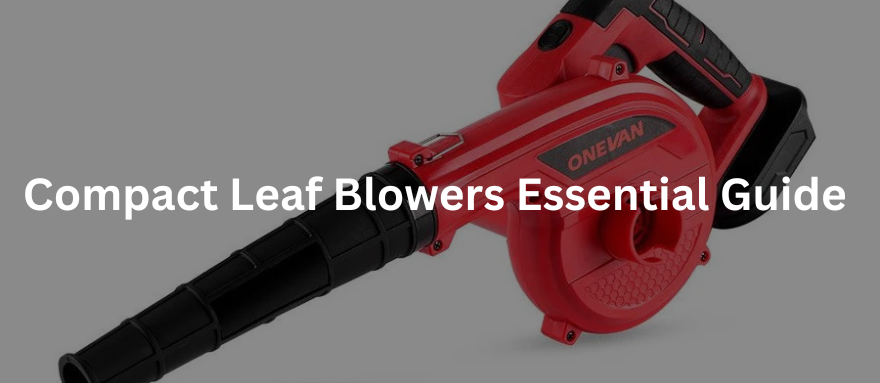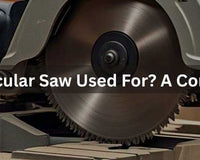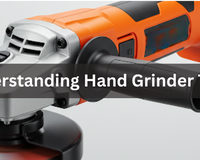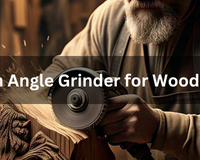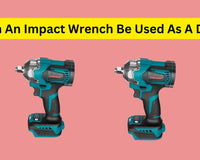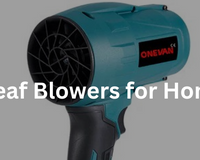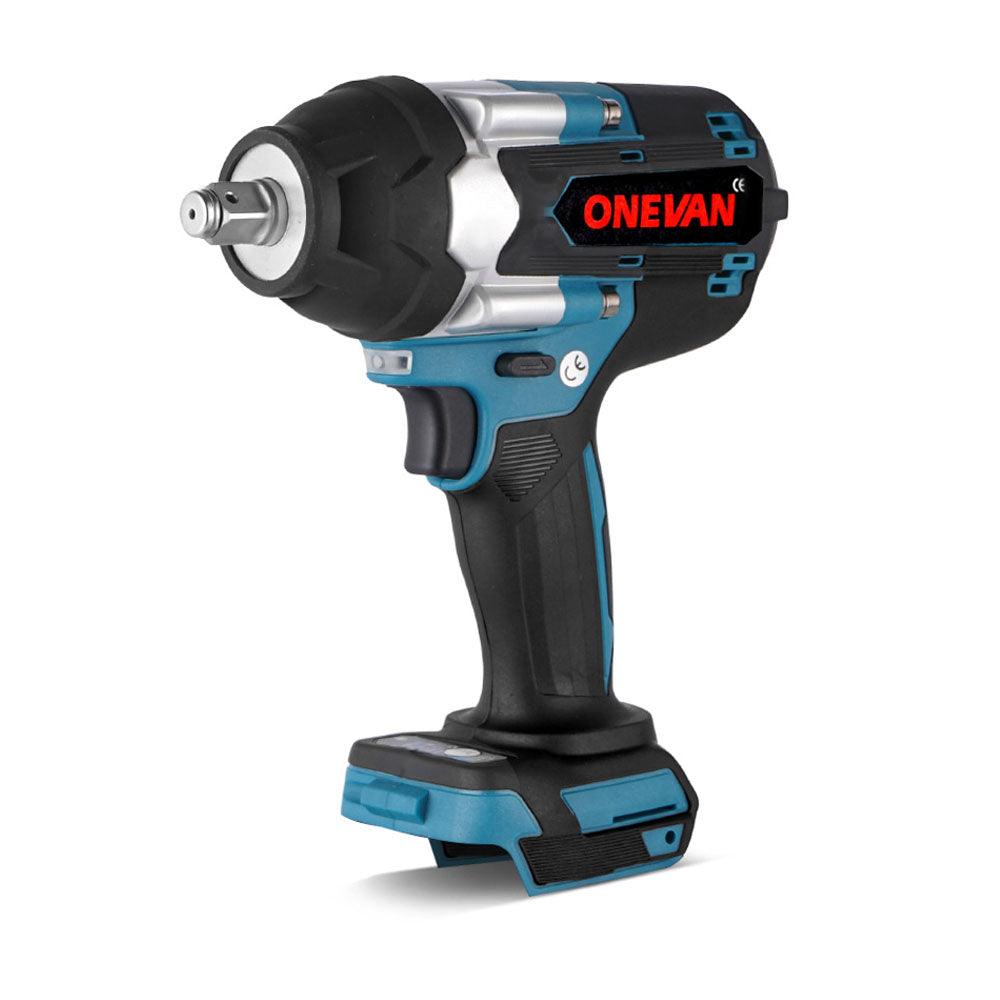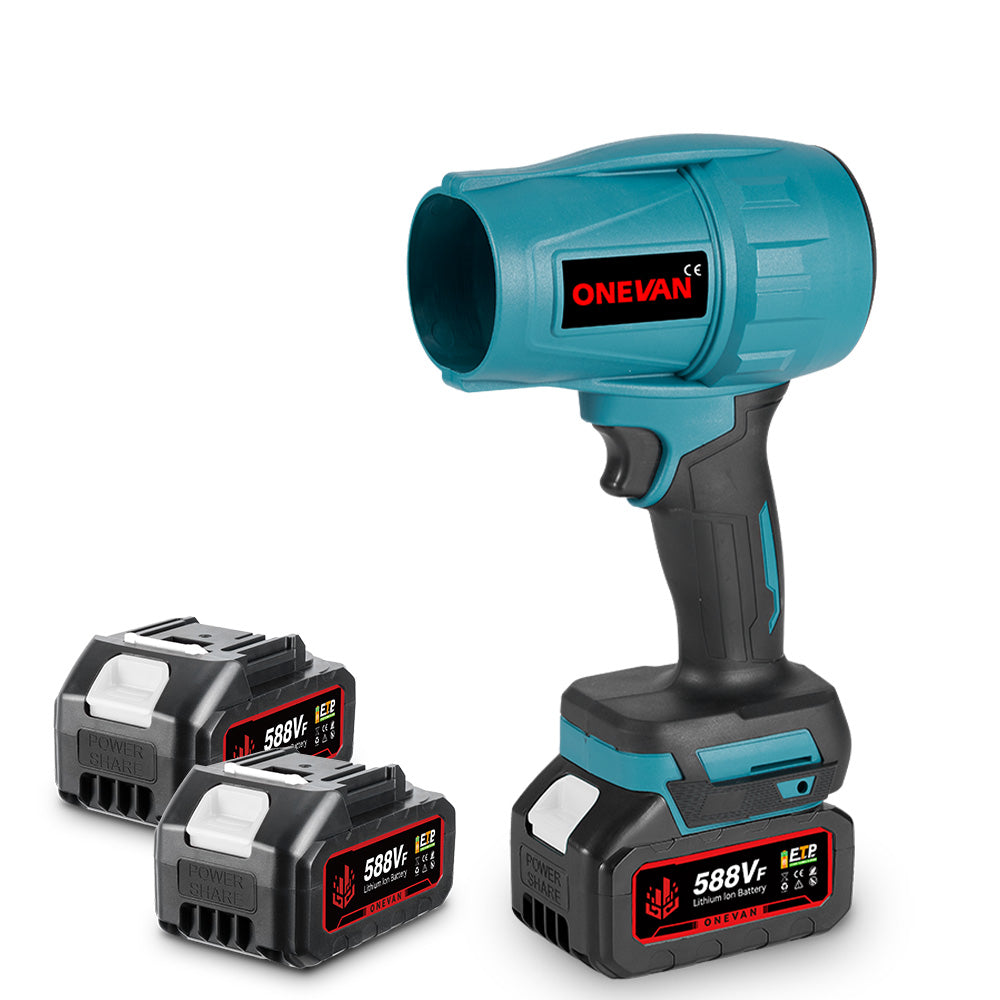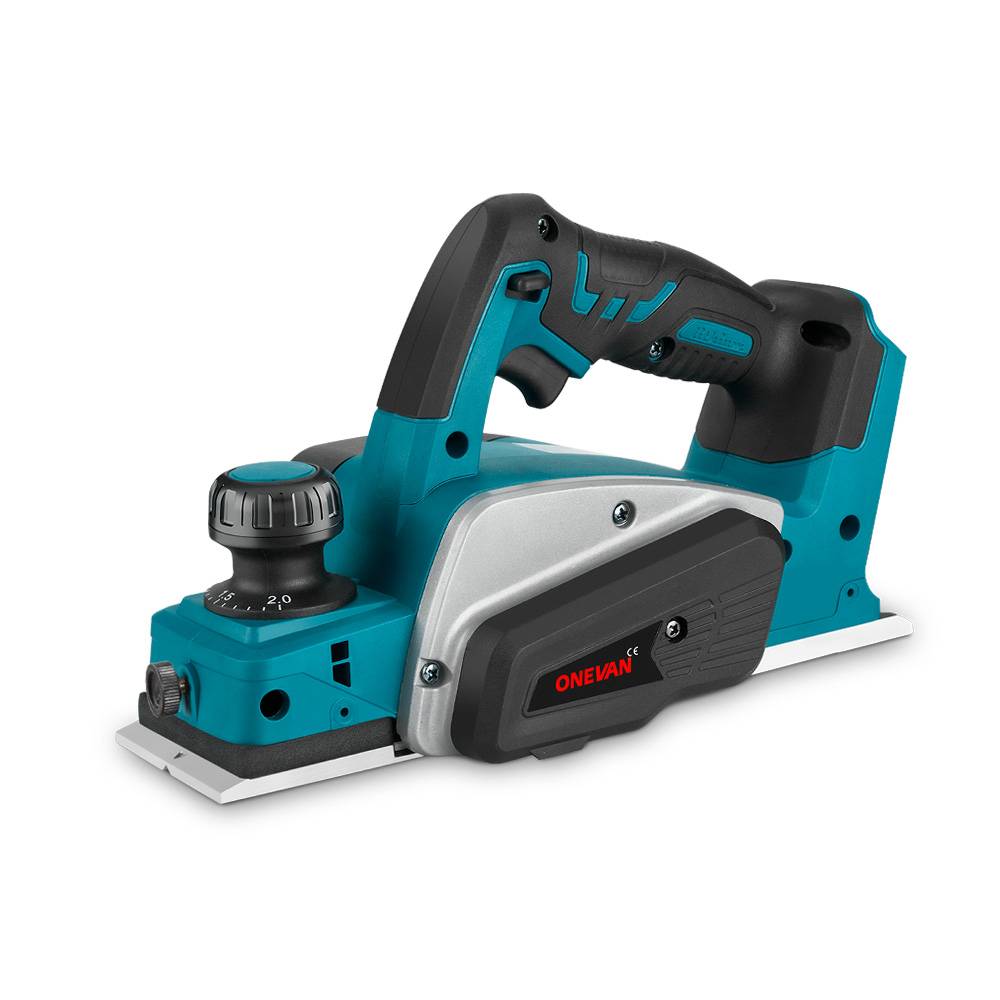How do you keep your garden and surrounding environment in an impeccable condition? Have you ever tried a compact leaf blower to wipe out debris from the patio and lawn? Battery leaf blowers are significantly effective in domestic environments. Numerous reasons contribute to the preference for compact leaf blowers over traditional models. In this article, you will read the significance, attributes, applications, and selection criteria for buying a reliable blower.
1. Understanding Compact Leaf Blowers

What are Compact Leaf Blowers?
Compact leaf blowers are diminutive and portable devices meticulously engineered for effortless outdoor upkeep. These lightweight tools, typically weighing between three and ten pounds, facilitate effortless transportation and maneuverability. Most compact models are equipped with battery-powered or electric motors, which provide ample power for expelling leaves and debris.
These blowers frequently generate air velocities ranging from 90 to 200 miles per hour (MPH) and airflow measured in cubic feet per minute (CFM), typically between 200 and 600 CFM. This harmonious blend of size and power renders them ideally suited for diminutive to medium-sized yards.
Compact Leaf Blowers Comparison with Standard Leaf Blowers
Compact leaf blowers differ from conventional leaf blowers in several key respects. Standard leaf blowers are typically larger and heavier, often incorporating gas engines that provide enhanced power but also increase weight. However, some standard models also use electric motors. These heavyweight machines can exceed ten pounds and require more meticulous maintenance.
In contrast, compact models proffer the convenience of being more lightweight and easier to manipulate, rendering them well-suited for expeditious cleanups. While standard blowers are capable of handling more expansive areas and more recalcitrant debris, compact models exude preeminence in residential settings where user-friendliness is a paramount concern.
2. Types of Compact Leaf Blowers
Compact Corded Leaf Blowers
Leaf blowers with cords are light and straightforward to use. They are great for small yards and can be plugged in. These fans can quickly move leaves and other things around. They can blow air up to 200 miles per hour and weigh about 5 to 10 pounds. Much air is also moved—between 300 and 600 cubic feet per minute. It would help to be careful where you use them since they have cords. These are great for small yards and places with a lot of noise.
Compact Cordless Leaf Blowers
Cordless leaf blowers' batteries can be charged repeatedly. They're great because there's no cord to mess up. They're easy to carry because most weigh between 4 and 8 pounds. In addition, they can blow air up to 200 MPH or 200 to 600 CFM. These blowers work great for medium-sized yards and can eliminate many different kinds of waste.
ONEVAN Brushless Cordless 5-Speed Snow/Leaf Blower has 5500 watts of power and can move 16 cubic meters of air per minute. The wind it blows is very strong, reaching 180 meters per second. You can adjust the speed to 5 different levels. It's quiet, so it won't bother your neighbors.
Compact Gas Leaf Blowers
Gas leaf fans get their power from petrol. They're usually more robust than electric models. They can move air at over 200 miles per hour and over 600 cubic feet per minute. However, they weigh more, usually between 10 and 15 pounds. Gas fans need more upkeep, like mixing the fuel and changing the oil more often. They can handle more significant sites and more demanding jobs.
Corded vs. Cordless vs. Gas-Powered Leaf Blowers
Consider a few factors when choosing between corded, cordless, and gas-powered leaf blowers.
|
Feature |
Corded Leaf Blower |
Cordless Leaf Blower |
Gas-Powered Leaf Blower |
|
Power Source |
Electrical outlet |
Gasoline |
|
|
Weight |
5-10 lbs |
4-8 lbs |
10-15 lbs |
|
Air Speed (MPH) |
150-250 |
150-250 |
200-300+ |
|
Airflow (CFM) |
300-600 |
200-600 |
600-1000+ |
|
Runtime |
Continuous (limited by cord) |
30-60 minutes (varies by battery) |
30-60 minutes (varies by tank size) |
|
Noise Level |
Relatively quiet |
Moderate noise |
Loud |
|
Maintenance |
Minimal |
Battery charging |
Fuel mixing, oil changes, tune-ups |
|
Cost |
Generally affordable |
Affordable |
Most expensive |
|
Best Suited For |
Small yards, noise-sensitive areas |
Medium-sized yards, general use |
Large yards, heavy-duty tasks |
3. How Do Compact Leaf Blowers Work?
Basic Components of a Leaf Blower
Motor: Electric or gasoline-powered motors propel compact leaf blowers. Electric motors have simple mechanism, consisting of a stator and rotor. Gasoline engines may be categorized as either two-stroke or four-stroke. The impeller or fan is actuated by the motor.
Fan/Impeller: An impeller, which is a fan made from materials like metal or plastic, is driven by the motor within the power head. The rapid rotation of the impeller generates centrifugal force, drawing air into the fan and expelling it out of the nozzle.
Nozzle: The nozzle is the tapered end of the blower tube. Its shape and size influence the airflow. Wider nozzles on vacuum blowers facilitate the suction of leaves. Subsequently, the narrower and flatter nozzles on leaf blowers concentrate the air jet for maximum force.
Compact leaf blowers generate airflow by spinning the impeller at high speeds, typically between 140-270 mph (63-121 m/s). The impeller draws air into the blower and accelerates it through the nozzle.
The airflow is measured in two key metrics:
- CFM (Cubic Feet per Minute): Measures the volume of air moved
- MPH (Miles per Hour): Measures the velocity or speed of the air
Higher CFM means more air volume for moving large piles of leaves, while higher MPH provides more force for blowing wet leaves or debris.
Compact designs balance power and efficiency by using high-speed motors and optimized impeller and nozzle shapes. This allows them to generate sufficient airflow while keeping the size and weight manageable for handheld use.
4. Advantages of Compact Leaf Blowers
Portability and ease of use
Compact leaf blowers excel at portability, making them excellent for households and landscapers. Their lightweight form allows users to navigate lawns, driveways, and patios easily. These gadgets are lightweight and portable, making them easy to transport.
The ergonomic handle and optimum weight distribution provide greater comfort during extended use. Many models have simple controls, allowing even beginners to operate them with little effort. The diminutive form also makes storage easier; you can tuck them away in tight locations like closets or garden sheds without taking up much room.
Furthermore, compact leaf blowers frequently come with variable speed settings. This function allows users to customize the airflow for specific purposes, such as a soft breeze for delicate flower beds or a forceful gust for removing stubborn garbage. The portability and easy design allow users to complete garden chores efficiently and effectively.
Compact leaf blowers are often less expensive than their larger counterparts. Their modest cost makes them more approachable to a broader spectrum of consumers, including homeowners who don't need the heavy-duty capability of bigger machines.
Manufacturers construct these blowers cost-effectively, employing fewer materials while maintaining performance. While full-sized blowers often have higher CFM and MPH ratings, compact ones provide adequate power for most home jobs, such as removing leaves, grass clippings, and light debris.
Additionally, the decreased operational costs add to their popularity. Many compact leaf blowers operate on electricity, which can drastically cut fuel costs compared to gas-powered ones. Electric blowers also require less maintenance, eliminating the need for oil changes and gasoline mixing. This combination of early savings and ongoing cost efficiency makes tiny leaf blowers appealing to budget-conscious users.
5. Applications of Compact Leaf Blowers
 Traditional Uses
Traditional Uses
Compact leaf blowers are good for clearing leaves, twigs, and other debris from lawns, gardens, and sidewalks. They save time and effort by quickly gathering and eliminating debris.
General garden maintenance benefits from compact leaf blowers as well. They can tidy paths of trash, clear flower beds, and pick up dropped petals.
Compact leaf blowers aid in preventing clogs and water damage by cleaning gutters of leaves, twigs, and other items. This essential equipment will let you sweep dirt, leaves, and other items off your driveway and patio.
Compact leaf blowers can rapidly dry surfaces like automobiles, furniture, pathways, or recently painted places. Though primarily intended for outdoor use, small leaf blowers can also be used indoors to clean dust, cobwebs, and other debris from hard-to-reach spots.
The strong airflow of a small leaf blower can blow out little gaps and cracks, eliminating dirt and trash. These versatile tools can assist in cleaning hard-to-access locations, such as under furniture or behind appliances.
Compact leaf blowers provide sustainable solutions to maintain cleanliness in garages or workshops by removing contaminants from the floor, equipment, and surfaces.
6. Choosing the Right Compact Leaf Blower
Before selecting a compact leaf blower, evaluate the specific tasks you intend to accomplish. You should consider some crucial factors such as area size, and what type of debris you will clean. For instance, if you need to clear vast areas with heavy leaves, buy a blower with higher power and airflow capacity. Conversely, if your tasks involve light debris on smaller surfaces, a less powerful model suffices.
Think about the frequency of use as well. While frequent users may look for models with improved durability and performance capabilities, occasional users could prioritize price and simplicity of use. It would help if you also questioned whether you need a blower for straightforward leaf clearance or more flexible chores, including blowing dirt, grass clippings, or even light snow.
When selecting a leaf blower, it is decisive to check power and performance metrics. Concentrate on two primary metrics: cubic feet per minute (CFM) and miles per hour (MPH).
- CFM measures the volume of air the blower can move. A higher CFM indicates the blower can clear larger areas more efficiently. For example, a blower rated at 500 CFM can handle significant leaf piles swiftly.
- MPH indicates the speed at which air exits the nozzle. A higher MPH rating provides greater force, enabling the blower to move heavier debris. For instance, a blower with 200 MPH can effectively displace wet leaves or twigs.
When assessing these ratings, balance your priorities. If your tasks require moving substantial volumes of leaves, prioritize CFM. If you often deal with heavier debris, focus on MPH.
Consider the power source as well. Battery-powered options offer convenience but may have limited runtime. Corded models provide continuous power but restrict mobility. Evaluate your yard size and the extent of your leaf-clearing tasks to determine which option aligns with your needs.
Weight and ergonomics significantly influence user comfort during operation. Compact leaf blowers should feature lightweight designs to minimize fatigue. Models weighing less than 10 pounds allow for extended use without causing fatigue.
Examine the handle design as well. Ergonomically shaped handles enhance grip and control, reducing the likelihood of slipping. Look for features such as adjustable handles or padded grips, which contribute to overall comfort.
Assess blower balance during operation. A well-balanced machine is simpler to maneuver in confined areas or over uneven terrain. Prioritizing comfort guarantees productive work without pain.
Noise pollution constitutes a significant concern for your neighbors. You need a calm and a powerful tool while living in residential areas. Many models emit sound levels exceeding 90 decibels, which can disturb neighbors and violate local noise ordinances.
When selecting a blower, pay attention to decibel ratings. Aim for models with lower ratings, ideally below 70 decibels, to minimize noise pollution. Some manufacturers now offer quieter electric models that effectively reduce operational noise while maintaining performance.
Think on the environmental consequences of your choice. Zero emissions produced by battery-powered leaf blowers make them a more ecologically friendly choice than gas-powered ones. Gas blowers create negative emissions and add to air pollution. Choosing a battery-operated model can help you to reduce your environmental impact and yet provide good leaf-clearing capacity.
Establishing a realistic budget is essential when selecting a compact leaf blower. Prices can vary significantly based on features, power, and brand. Entry-level models typically range from $50 to $150, offering basic functionality suitable for light tasks.
Mid-range options, priced between $150 and $300, often provide enhanced power, better CFM and MPH ratings, and additional features such as variable speed settings or ergonomic designs. High-end models, exceeding $300, deliver superior performance, durability, and advanced features, making them suitable for professional landscapers or frequent users.
Consider long-term maintenance, battery replacement, and gas model fuel expenses while budgeting. Quality blowers may last longer and function better, saving you money.
7. Conclusion
Compact leaf blowers offer a handy and practical answer for various outside chores. Professionals in landscaping and homeowners will find them perfect because of their adaptability, simplicity of use, and mobility. Compact leaf blowers are a dependable and robust instrument for any goal—clearing leaves, cleaning gutters, or drying surfaces.
By understanding the various types of compact leaf blowers, including their features and applications, you can wisely choose the best compact leaf blower that aligns with your specific requirements.
8. FAQs
1. CFM vs. MPH in leaf blowers: which is more important?
A blower's CFM measures air volumetric flow. Higher CFM means more air.
Air velocity from the blower is measured in MPH. Higher MPH means quicker airflow.
CFM and MPH are important, but the best mix depends on your demands. Clearing heavy debris requires high CFM. High MPH may be better for sensitive operations like blowing leaves off a vehicle.
2. How long do cordless compact leaf blower batteries last?
Cordless compact leaf blowers' battery life depends on model, capacity, and use. An entirely charged battery may last 30 minutes to 2 hours. Newer versions may have various battery options and last longer.
3. Do compact leaf blowers work for vast yards, or should I get a bigger one?
Compact leaf blowers work effectively in small to medium yards. For big yards or heavy activities, a full-sized leaf blower may work better. Recent technological advances have made tiny variants more powerful, making them suitable for numerous purposes.
4. Compact leaf blowers produce noise. How can I lessen it?
Choose a quieter model: Some leaf blowers are quiet in design.
Protect your ears: Use earplugs or headphones to protect your hearing.
Avoid blowing early in the morning or late at night to avoid disturbing neighbors.
5. Can a tiny leaf blower dry my car?
Yes, a tiny leaf blower can dry your automobile. Be cautious when using it near painted surfaces, as high-pressure air might damage the paint. Keep your distance and move the blower constantly.

